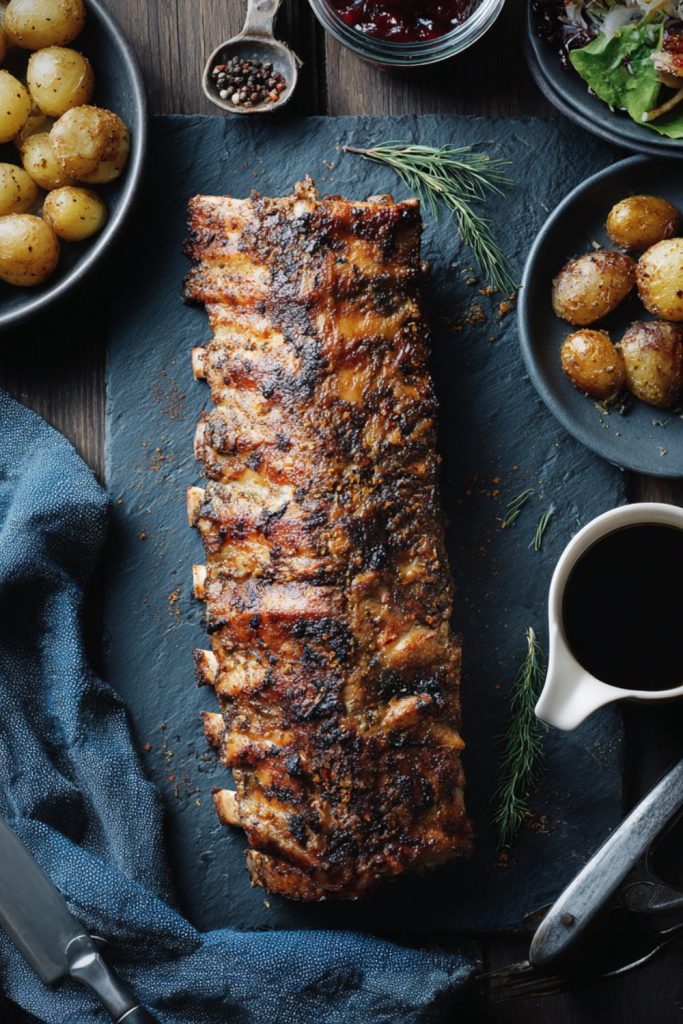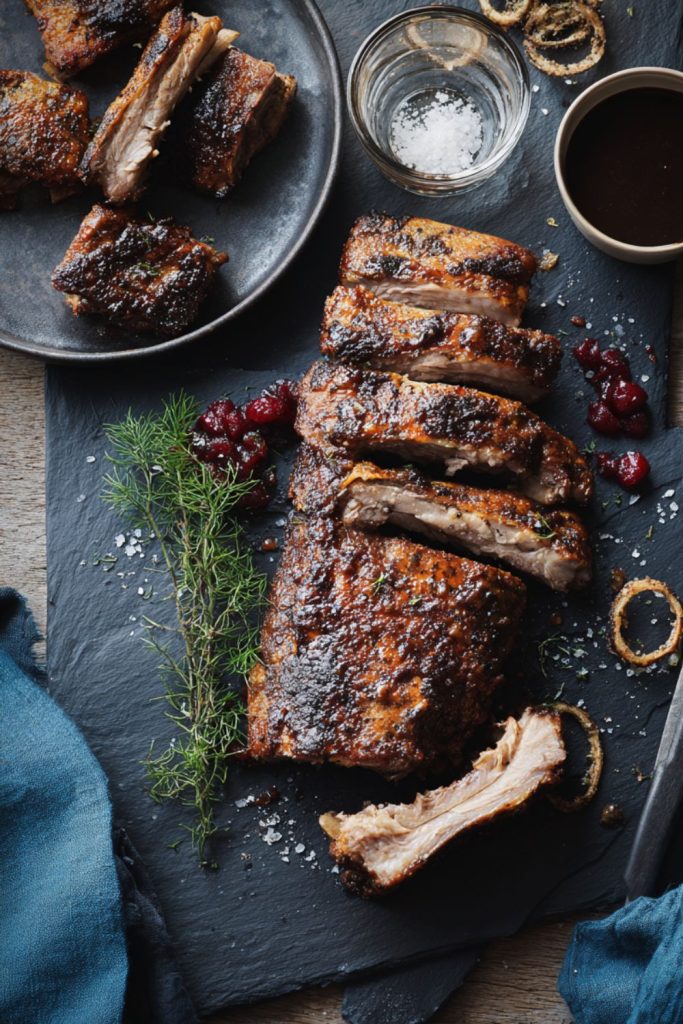This hearty Nigella Norwegian Pork Ribs recipe is made with bone-in pork belly, fresh dill, garlic, juniper berries, and Maldon sea salt. The result is incredibly tender, juicy meat and a perfectly crispy, crunchy crackling. It’s a fantastic main course. This dish is perfect for a special Sunday roast or a cozy winter feast, serving 4-6 people with leftovers.
Nigella Norwegian Pork Ribs Ingredients
- 2.5 – 3 kg (approx. 5.5 – 6.6 lbs) bone-in, skin-on pork belly
- 3 fat cloves garlic
- 3 tbsp Maldon sea salt flakes (or 1.5 tbsp fine sea salt)
- 1 tsp juniper berries
- 1 large bunch fresh dill
- 2 onions
- 250 ml (1 cup) hot water, from a just-boiled kettle

How To Make Nigella Norwegian Pork Ribs
- Let the pork rest: Take the pork out of the fridge about 1 hour before you plan to cook it. Unwrap it and lay it rind-side down on a large chopping board.
- Make the herb paste: Peel the garlic cloves and add them to a pestle and mortar (a small, heavy bowl used for crushing). You can also use a small bowl with a stick blender. Add 2 tablespoons of the sea salt, the juniper berries, and the stalks from your dill. Crush, grind, or blend until you have an aromatic green paste.
- Season the meat: Take the paste to your pork. On the meat side, you will see two long troughs where the butcher sawed through the bones. Press the paste evenly into these cuts. If needed, run a knife through the cuts to open them up.
- Add the dill: Push as many of the fresh dill fronds as you can fit into the paste-filled cuts.
- Salt the rind: Turn the pork over so the rind (skin) is facing up. Rub the entire rind and the sides of the pork with the remaining 1 tablespoon of sea salt flakes.
- Create an onion platform: Get a large roasting tin (approx. 34 x 37 cm / 13 x 15 in). Peel the onions and cut each one into 3 thick slices. Arrange these slices in the tin to create a “platform” for the pork.
- Position the pork: Place the pork, rind-side up, on top of the onion slices. Arrange the onions so that one end of the pork is slightly higher than the other. This helps the liquid drain off and prevents it from pooling on the rind.
- Rest and preheat: Let the pork sit in the tin at room temperature for about 1 hour. When you are ready, preheat the oven to 220°C / 200°C Fan / 425°F.
- Start the first roast: Pour the 250ml (1 cup) of hot water into the bottom of the roasting tin, around the pork. Cover the entire tin tightly with aluminum foil. Cook in the hot oven for 45 minutes. This step helps soften the rind.
- Score the rind: After 45 minutes, take the tin out of the oven and remove the foil. The rind should look soft and a little puffed up. Use a large, sharp knife to score the rind into 2cm / 3/4-inch squares. If the butcher already scored it, just cut deeper into the original marks.
- Begin the second roast: Turn the oven temperature down to 170°C / 150°C Fan / 325°F. Put the pork back into the oven without the foil. Make sure it is still propped up on the onions.
- Cook until tender: Let the pork roast for 2.5 hours. At this point, much of the fat will have rendered (melted) into the meat and the tin. Poke the tip of a knife into the pork. If it doesn’t feel tender, leave it in for another 30 minutes.
- Create the crackling: Turn the oven back up to 220°C / 200°C Fan / 425°F. Give the pork around 15 minutes at this high heat. Watch it closely to make sure the rind doesn’t burn. You want it to become deep gold, crunchy, and popped up.
- Rest and carve: Carefully remove the pork from the oven and move it to a carving board. The crackling will be hard. Use poultry shears or kitchen scissors to cut through the crackling first. Then, use a sharp knife to slice down into the meat, cutting a chunky rib section for each person.
Recipe Tips
- Don’t Skip the Room Temp Rest: Letting the pork sit out for an hour is important. Placing cold meat in a hot oven can make it tough. This step helps it cook more evenly.
- The Onion Platform is Key: The onion slices do more than add flavor. They lift the pork out of the fat that renders during cooking. This is essential for preventing a soggy bottom and helping the rind get crispy.
- Salt Makes the Crackling: The salt rub does two things. It seasons the pork and, more importantly, it draws moisture out of the skin. Dry skin is the secret to perfect, crunchy crackling.
- Score After Softening: It is much easier to score the rind after the first 45-minute covered roast. The steam softens the skin, allowing you to cut through it easily.
- Juniper Berries: These berries add a traditional, pine-like Nordic flavor. If you cannot find them, you can leave them out, and the dill and garlic will still provide a wonderful flavor.
What To Serve Norwegian Pork Ribs
Serve these rich Norwegian Pork Ribs with classic roasted potatoes and gravy. It’s also fantastic with braised red cabbage, simple boiled potatoes, or a side of steamed green beans. For a traditional touch, offer a small bowl of lingonberry jam or simple applesauce to cut through the richness. A crisp green salad with a sharp vinaigrette also provides a nice, fresh contrast.

How To Store Pork Ribs Leftovers
- Refrigerate: Store leftover pork in an airtight container in the refrigerator for up to 3 days. Please note that the crackling will lose its crispness once chilled. To reheat, place the meat in an oven-safe dish until warmed through.
- Freeze: You can freeze the cooked meat (it’s best to remove the crackling first) in a freezer-safe container for up to 2 months. Thaw overnight in the refrigerator before reheating.
Nigella Norwegian Pork Ribs Nutrition Facts
Approximate values per serving, assuming 6 servings.
- Calories: 750 kcal
- Total Fat: 65g
- Saturated Fat: 24g
- Cholesterol: 120mg
- Sodium: 900mg
- Total Carbohydrate: 3g
- Dietary Fiber: 1g
- Sugars: 1g
- Protein: 38g
Frequently Asked Questions
- My crackling didn’t get crispy. What went wrong? This usually happens if there is too much moisture. Make sure your rind is very dry before you rub it with salt. Also, double-check that your pork is propped up on the onions and not sitting in the pan juices, which will make it soggy. The final 15-minute blast of high heat is essential.
- Can I use pork belly without the bone? Yes, you can use a boneless pork belly slab. The cooking time might be slightly shorter, so start checking for tenderness after 2 hours. Since you won’t have the bone-side cuts, just rub the herb paste all over the meat side of the pork.
- Why do I cover it with foil first? The initial 45 minutes covered in foil steams the pork rind. This important step softens the tough skin, which makes it very easy to score. It also helps the rind puff up later, leading to a lighter, crispier crackling instead of a hard, dense one.
- What if I can’t find Maldon sea salt flakes? Maldon flakes are large and have a clean taste. If you can’t find them, you can use another flaky sea salt. The recipe also provides a measurement for fine sea salt (1.5 tablespoons total) if that is all you have.
Try More Recipes:
- Nigella Lawson Lamb Curry Recipe
- Nigella Quick Chilli Recipe
- Nigella Butternut with Beetroot, Chilli and Ginger Sauce

Nigella Norwegian Pork Ribs
Description
This hearty Nigella Norwegian Pork Ribs recipe creates an unforgettable main course. It features tender, juicy pork belly seasoned with dill, garlic, and juniper, all topped with a perfect, crunchy layer of golden crackling.
Ingredients
Instructions
- Prep the pork: Let the pork rest at room temperature for 1 hour. Lay it rind-side down.
- Make the herb paste: In a pestle and mortar, blend the garlic, 2 tablespoons of sea salt, juniper berries, and dill stalks into a green paste.
- Season the meat: Press the paste evenly into the long cuts on the bone-side of the pork. Push in the dill fronds.
- Salt the rind: Turn the pork over (rind-side up) and rub the entire rind and sides with the remaining 1 tablespoon of sea salt.
- Prepare the tin: Peel and slice the onions into 3 thick rounds each. Arrange them in a large roasting tin as a platform. Place the pork on top, with one end slightly higher than the other.
- Preheat and first roast: Preheat the oven to 220°C / 425°F. Pour the hot water into the tin (not on the pork). Cover the tin tightly with foil and roast for 45 minutes.
- Score the rind: Remove the foil. The rind will be soft. Use a sharp knife to score the rind into 2cm / 3/4-inch squares.
- Second (low) roast: Reduce the oven temperature to 170°C / 325°F. Return the pork to the oven, uncovered, and roast for 2.5 hours, or up to 3 hours, until the meat is very tender.
- Create the crackling: Turn the oven temperature back up to 220°C / 425°F. Roast for another 15 minutes, or until the rind is deep golden, crunchy, and popped. Watch closely so it does not burn.
- Carve and serve: Let the pork rest for a few minutes. Use kitchen scissors to cut through the crackling, then a knife to slice the meat between the ribs.

